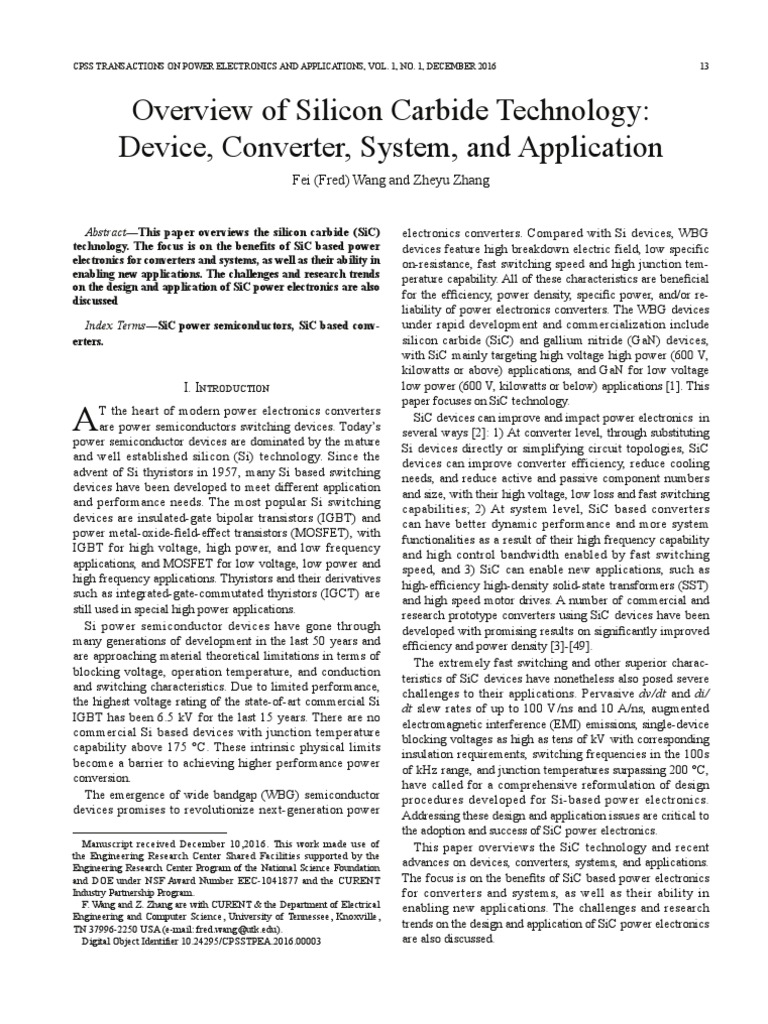Silicon carbide (SiC) has surged to prominence within the realm of power electronics, attributable to its remarkable properties that can significantly enhance device performance. This article delves into the use of silicon carbide, elucidating its multifaceted applications, intrinsic advantages over traditional materials, and the future potential it holds within various technological domains.
Initially, one must consider the material’s unique composition. Silicon carbide is a semiconductor that consists of silicon and carbon, forming a crystalline structure that bestows it with exceptional thermal conductivity and a wide bandgap. These characteristics render SiC a formidable contender when addressing the challenges posed by modern electronic devices, particularly in high-power and high-temperature applications.
At the core of silicon carbide’s utility is its superior performance in power electronics. Traditionally, silicon (Si) has dominated the semiconductor industry; however, as the demand for energy-efficient systems escalates, the limitations of silicon become increasingly apparent. Silicon carbide exhibits a bandgap of approximately 3.2 eV, which is significantly larger than silicon’s 1.1 eV. This wide bandgap enables SiC devices to operate at higher voltages, frequencies, and temperatures, making them exceptionally suited for high-power applications such as electric vehicles (EVs) and renewable energy sources.
Electric vehicles have become a focal point for silicon carbide integration. As the automotive industry pivots toward electrification, the demand for power electronic devices capable of supporting efficient energy conversion becomes paramount. SiC is instrumental in power inverters, which convert DC energy from batteries into AC energy to drive electric motors. The efficiency gains derived from using SiC in these applications not only enhance performance but also contribute to the overall range and durability of electric vehicles.
Moreover, silicon carbide’s resilience under arduous conditions positions it as a desirable component in renewable energy systems. For instance, in photovoltaic applications, SiC power electronics can facilitate smooth energy conversion, optimizing the efficiency of solar inverters. The high thermal conductivity of SiC translates to improved thermal management, which is essential in maximizing energy output from solar energy installations. As the world seeks to transition to greener energy solutions, SiC stands as a pivotal player in the renewable energy portfolio.
Beyond automotive and renewable energy domains, silicon carbide’s role extends into industrial applications. The demand for efficient motor drives in manufacturing processes necessitates the use of robust and reliable power electronics. Silicon carbide devices demonstrate lower switching losses when compared to their silicon counterparts, leading to reduced energy consumption and improved overall system efficiency. This attribute becomes particularly beneficial in applications requiring high-frequency operations, where additional losses become prominent. The implementation of SiC-based systems can culminate in significant cost savings over time, reinforcing its appeal in industrial contexts.
In addition to these applications, silicon carbide also plays a critical role in the burgeoning field of telecommunications. The advent of 5G technology calls for innovations that can handle increased power levels and operate over broad frequency ranges. Silicon carbide offers superior performance in both aspects, enabling enhanced signal transmission and reduced latency — factors that are paramount in achieving the seamless connectivity desired in modern communication infrastructures. The reliability and robustness in high-frequency environments further accentuate SiC’s effectiveness, marking it as a linchpin in the rollout of next-generation communication technology.
As we contemplate the trajectory of silicon carbide’s application landscape, it becomes apparent that its adoption is poised to expand beyond existing realms. At the intersection of emerging technologies lies the potential for SiC to revolutionize sectors such as aerospace and space exploration. The extreme operational conditions encountered in such environments necessitate materials capable of withstanding significant stress and maintaining operational integrity. Silicon carbide’s thermal and electrical properties make it an enticing candidate for high-performance aerospace components, such as propulsion systems and satellite electronics.
Furthermore, the exploration into silicon carbide’s compatibility with wide-bandgap semiconductor technologies provides a fertile ground for innovation. Researchers are investigating its synergies with gallium nitride (GaN), another wide-bandgap material that has carved its niche in high-frequency applications. The combinatorial effects of SiC and GaN may yield devices that harness their complementary advantages — combining the high breakdown voltages of SiC with the superior efficiency of GaN. Such explorations could usher in the next generation of power electronics, dramatically influencing various technological domains.
In conclusion, the utility of silicon carbide transcends traditional boundaries, marking it as a pivotal force in the advancement of power electronics and beyond. Its exceptional attributes render it indispensable in high-performance applications, particularly within the automotive, renewable energy, industrial, and telecommunications sectors. As research propels forward, unveiling new synergies and applications, silicon carbide is positioned to play an integral role in shaping the future of technology. As we stride deeper into the 21st century, the fascination with silicon carbide will inevitably persist, propelled by its dynamic capabilities and potential to address the escalating demands of modern society.












